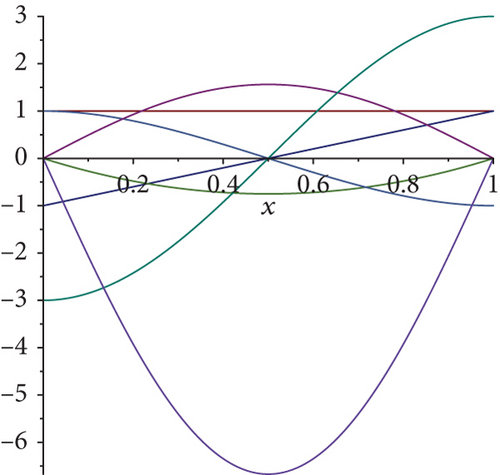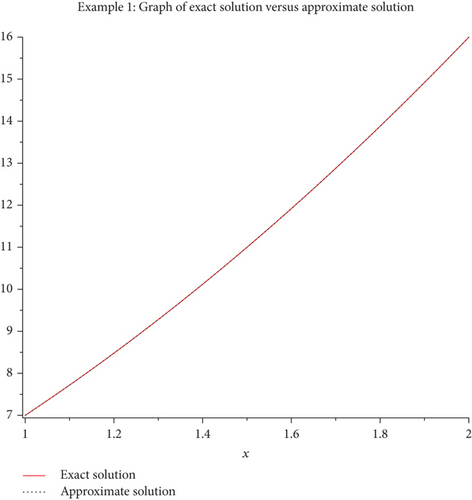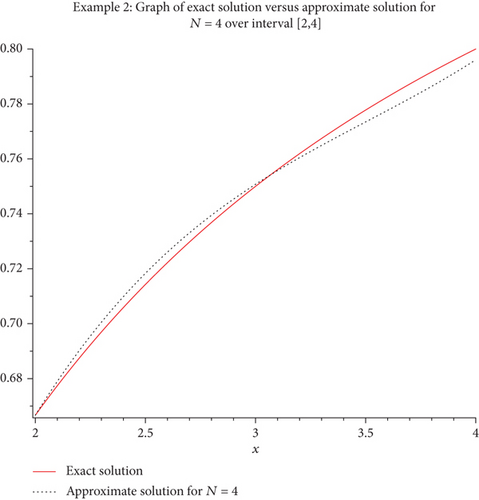Numerical Solution for Arbitrary Domain of Fractional Integro-differential Equation via the General Shifted Genocchi Polynomials
Abstract
The Genocchi polynomial has been increasingly used as a convenient tool to solve some fractional calculus problems, due to their nice properties. However, like some other members in the Appell polynomials, the nice properties are always limited to the interval defined in [0, 1]. In this paper, we extend the Genocchi polynomials to the general shifted Genocchi polynomials, , which are defined for interval [a, b]. New properties for this general shifted Genocchi polynomials will be introduced, including the determinant form. This general shifted Genocchi polynomials can overcome the conventional formula of finding the Genocchi coefficients of a function f(x) that involves f(n − 1)(x) which may not be defined at x = 0, 1. Hence, we use the general shifted Genocchi polynomials to derive the operational matrix and hence to solve the Fredholm-type fractional integro-differential equations with arbitrary domain [a, b].
1. Introduction
The Genocchi polynomials, Gn(x), is one of the members of the Appell polynomials, An(x), satisfying the differential relation (dAn (x))/dx = nAn−1(x), n = 1, 2, 3, ⋯. Besides, many new results are obtained in the field of number theory and combinatory [1–4], the Genocchi polynomials are also applied successfully to solve some kind of fractional calculus problems, and its advantages were described in [5–9] mostly via its operational matrix. However, most of the results are applied over the interval [0, 1]. Furthermore, for function approximation by using the Genocchi polynomials, the conventional formula of finding the Genocchi coefficients of a function f(x) involves f(n − 1)(x) which may not be defined at x = 0, 1. To overcome these drawbacks, we propose the general shifted Genocchi polynomials which are more suitable for larger interval [a, b], where a, b ≥ 0. Hence, in this paper, with the new general shifted Genocchi polynomials, we derive its operational matrix, and then, we solve the fractional integro-differential equation (FIDE) with arbitrary domain, i.e., not limited to interval [0, 1].
On top of that, solving FIDE is always not an easy task, and reliable numerical methods are needed. Furthermore, for the Fredholm-type problems, the existing numerical methods are mostly applicable for interval [0, 1]. Some of the early published works which for FIDE in [0, 1] are including the collocation method via polynomial spline function [10], the fractional differential transform method [11], and the Taylor expansion method [12]. In this research direction, some researches focus on solving the special class of FIDE, which includes solving fractional partial integro-differential equations by the resolvent kernel method, the Laplace transform [13], and the Laguerre polynomial [14], solving fractional integro-differential equations via the fractional-order Euler polynomials [15] and the Jacobi wavelets [16], solving fourth-order time FIDE with a weakly singular kernel by compact finite difference scheme [17] and nonlinear time-fractional partial integro-differential equation by finite difference scheme [18], and solving nonlinear two-dimensional fractional integro-differential equations via hybrid function [19]. However, the FIDE with the arbitrary domain is relatively less concerned by researchers, and so far, the successful methods applied to this type of problem are limited to the Chebyshev wavelet method [20]. For more methods as well as theories of FIDE/FDE, we refer the readers to some well-known books such as [21, 22].
The rest of the paper is organized as follows: Section 2 is devoted to preliminary results including basic definition, properties and determinant form of the general shifted Genocchi polynomials, , function approximation by , and theorem for the analytical expression of the integral of the product of the two general shifted Genocchi polynomials . Section 3 is the main result of this paper, which includes the derivation of a new operational matrix associated with the general shifted Genocchi polynomials. Besides that, the procedure of approximating the integral kernel in terms of the general shifted Genocchi polynomials and analytical expression of the kernel matrix is also explained in this section. Sections 4 and 5 are devoted to the procedure used in this paper and some numerical examples. Section 6 is the conclusion of this paper.
2. Preliminary Results
2.1. General Shifted Genocchi Polynomials: Definitions and Basic Properties
Equation (5) fails to work for functions that are not (n − 1)-differentiable at the points x = 0 or x = 1. An example is given as follows where the coefficient, c3, is undefined:
To avoid this problem, we define the general shifted Genocchi polynomials by shifting Gn(x) from the interval [0, 1] to the interval [a, b], 0 ≤ a ≤ b, i.e., Sn(x) = Gn((x − a)/(b − a)), which results in the following definition:
Definition 1. The general shifted Genocchi polynomials of order n is defined over the interval [a, b] as
Figures 1 and 2 show the first few original Genocchi polynomials and the general shifted Genocchi polynomials.


Theorem 2. Given an arbitrary integrable continuous function f(x) ∈ CN−1(R), it can be approximated in terms of the general shifted Genocchi polynomials up to order N (i.e., polynomial degree = N − 1) by
2.2. Determinant Form of the General Shifted Genocchi Polynomial Sequence
In this subsection, we will explain that this new general shifted Genocchi polynomial sequence can be also expressed in determinant form and recurrence relation, via modifying the work in [25, 26] for the shifted Genocchi polynomial sequence. For this process, we shift the order of the general shifted Genocchi polynomial sequence from n to n + 1; that is, we have , where denotes the general shifted Genocchi polynomial sequence.
Lemma 3. The determinant form of the general shifted Genocchi polynomial sequence, , which n > 0, is given by
In order to obtain values for si,j, we follow Costabile et al.’s method [25], which we summarize as follows:
Step 1. From , we obtain the general shifted Genocchi number, ; hence, we calculate the lower triangular Toeplitz matrix, TS, with entries
Step 2. Calculate the upper triangular matrix S via
2.3. Integral of Product of the General Shifted Genocchi Polynomials
In this subsection, we derive the analytical expression for the integral of the product of the two general shifted Genocchi polynomials which will be used frequently in the later parts of the paper. This results in the following theorem:
Theorem 4. Given any two general shifted Genocchi polynomials , for 0 ≤ x
Proof. In order to prove this theorem, we need the following expression:
For
By using Equation (25), we obtain
These processes continue recursively for n times, and then, we will obtain
3. Main Result
3.1. General Shifted Genocchi Polynomial Operational Matrix of Fractional Derivative
To derive the , we first prove the following Lemma 5.
Lemma 5. Caputo’s fractional derivative of fractional order α of a general shifted Genocchi polynomial, , of order i is given by
Proof. For n − 1 < α ≤ n, n = ⌈α⌉
Substitute t = xu,
Hence, we obtain the theorem for operational matrix as follows:
Theorem 6. Given a set of the N general shifted Genocchi polynomials, the general shifted Genocchi polynomial operational matrix of fractional derivative in the Caputo sense of order α over the interval [0, 1] is the N × N matrix , given by
Proof. Let . Then, using the function approximation as in Theorem 2 and Caputo’s fractional derivative for in Lemma 5, we have
As the formula given in Theorem 6 may fail to work for a = 0, we use the matrix approach to derive the as given in Theorem 8. To prove Theorem 8, we need the following lemma:
Lemma 7. The matrix ΘN defined as is given by
Proof. From Caputo’s fractional derivative of the Genocchi polynomials [5, 23, 24], we have
Integrate both sides, and we obtain
Theorem 8. Given a set of the N general shifted Genocchi polynomials, the general shifted Genocchi polynomial operational matrix of Caputo’s fractional derivative of order α over the interval [a, b] is the N × N matrix , given by
Proof. From Equation (29),
3.2. Approximation of Integral Kernel by the General Shifted Genocchi Polynomials
We present two approaches for obtaining the kernel matrix KS.
3.2.1. Method 1: Conventional Genocchi Coefficient Formula
Using the conventional method of finding the Genocchi coefficients for a single variable function f(x), we can extend the formula to a two-variable function K(x, t) which is continuous and (N − 1) differentiable in interval [0, 1]. This results in the following theorem:
Theorem 9. Let K(x, t) be a two-variable continuous function in CN−1([0, 1]). Then, K(x, t) can be approximated in terms of the general shifted Genocchi polynomials up to order N, i.e., , where S is the general shifted Genocchi polynomial basis matrix and KS is the N × N integral kernel matrix in the general shifted Genocchi basis given by
Proof. Assume that the kernel K(x, t) is approximated using N number of the general shifted Genocchi polynomials, i.e.,
Set . Hence, . Using the formula of the general shifted Genocchi coefficients for (i.e., Theorem 2 with respect to t variable),
Now using the above expression of ϕj(x) together with the formula of the general shifted Genocchi coefficients for (i.e., with respect to x variable) instead, we obtain
In a similar way, the above approach can be extended to finding the general shifted Genocchi coefficients for the approximation of a multivariable function.
3.2.2. Method 2: Matrix Method
The classical way will not work for the kernel function not differentiable at x, t = 0, 1; then, we can adopt the matrix approach similar to that of finding the general shifted Genocchi coefficients in Theorem 2 to arrive at the following theorem:
Theorem 10. Let K(x, t) be a two-variable continuous function in CN−1([a, b]). Then, K(x, t) can be approximated in terms of the general shifted Genocchi polynomials up to order N, i.e., , where S is the general shifted Genocchi polynomial basis matrix and KS is the N × N integral kernel matrix in the general shifted Genocchi basis given by
Proof. From, K(x, t) ≈ ST(x)KSS(t),
4. Procedure of Solving Arbitrary Domain Fractional Integro-differential Equation
5. Numerical Examples
Here are two examples of FIDE of Equation (1) which are solved using the proposed method via the general shifted Genocchi polynomials and its operational matrix. The computation was done via Maple software.
Example 1. Consider the following FIDE:
Let f(1) = 7, the exact solution is f(x) = 2x2 + 3x + 2. Since [a, b] = [1, 2], we use the general shifted Genocchi polynomials over the interval [1, 2], i.e., to solve the problem. Let us choose N = 4 to approximate .
The proposed method gives the general shifted Genocchi coefficients as c1 = 23/2, c2 = 9/2, c3 = 2/3, c4 = 0, and therefore, the approximate solution produced is which reproduces the exact solution over the interval [1, 2]. Figure 3 shows both f(x) and f∗(x) over the interval [1, 2]. The numerical results and absolute errors are shown in Table 1.

| t | Exact sol. f(x) | Approx. sol. f∗(x) | Abs. error |f(x) − f∗(x)| |
|---|---|---|---|
| 1.0 | 7.0000000000 | 7.0000000000 | 0 |
| 1.1 | 7.7200000000 | 7.7200000000 | 0 |
| 1.2 | 8.4800000000 | 8.4800000000 | 0 |
| 1.3 | 9.2800000000 | 9.2800000000 | 0 |
| 1.4 | 10.1200000000 | 10.1200000000 | 0 |
| 1.5 | 11.0000000000 | 11.0000000000 | 0 |
| 1.6 | 11.9200000000 | 11.9200000000 | 0 |
| 1.7 | 12.8800000000 | 12.8800000000 | 0 |
| 1.8 | 13.8800000000 | 13.8800000000 | 0 |
| 1.9 | 14.9200000000 | 14.9200000000 | 0 |
| 2.0 | 16.0000000000 | 16.0000000000 | 0 |
Example 2. Consider the following FIDE:
Let f(2) = 2/3, the exact solution is f(x) = x/(x + 1). Let us choose orders of N = 4 of the general shifted Genocchi polynomials over the interval [a, b] = [2, 4] to approximate f(x) and compare the graphs and absolute errors between the exact solution and approximate solutions of orders N = 4. Figure 4 shows both f(x) and f∗(x) of orders N = 4 over the interval [2, 4]. The numerical results and absolute errors are shown in Table 2, which shows our method of high accuracy.

| t | Exact sol. f(x) | Approx. sol. f∗(x) | Abs. error |f(x) − f∗(x)| |
|---|---|---|---|
| 2.0 | 0.6666666667 | 0.6666666670 | 3.00000E − 10 |
| 2.1 | 0.6774193548 | 0.6790021440 | 1.58279E − 03 |
| 2.2 | 0.6875000000 | 0.6902602348 | 2.76023E − 03 |
| 2.3 | 0.6969696970 | 0.7005176063 | 3.54791E − 03 |
| 2.4 | 0.7058823529 | 0.7098509254 | 3.96857E − 03 |
| 2.5 | 0.7142857143 | 0.7183368566 | 4.05114E − 03 |
| 2.6 | 0.7222222222 | 0.7260520712 | 3.82985E − 03 |
| 2.7 | 0.7297297297 | 0.7330732332 | 3.34350E − 03 |
| 2.8 | 0.7368421053 | 0.7394770103 | 2.63490E − 03 |
| 2.9 | 0.7435897436 | 0.7453400700 | 1.75033E − 03 |
| 3.0 | 0.7500000000 | 0.7507390792 | 7.39079E − 04 |
| 3.1 | 0.7560975610 | 0.7557507047 | 3.46856E − 04 |
| 3.2 | 0.7619047619 | 0.7604516132 | 1.45315E − 03 |
| 3.3 | 0.7674418605 | 0.7649184721 | 2.52339E − 03 |
| 3.4 | 0.7727272727 | 0.7692279476 | 3.49933E − 03 |
| 3.5 | 0.7777777778 | 0.7734567083 | 4.32107E − 03 |
| 3.6 | 0.7826086957 | 0.7776814195 | 4.92728E − 03 |
| 3.7 | 0.7872340426 | 0.7819787491 | 5.25529E − 03 |
| 3.8 | 0.7916666667 | 0.7864253656 | 5.24130E − 03 |
| 3.9 | 0.7959183673 | 0.7910979325 | 4.82043E − 03 |
| 4.0 | 0.8000000000 | 0.7960731198 | 3.92688E − 03 |
6. Conclusion
In this paper, the 2nd-kind nonhomogeneous Fredholm FIDE is solved using the general shifted Genocchi polynomials . We introduce the general shifted Genocchi polynomials and derive the formula for computing the general shifted Genocchi coefficients. Some new properties for the general shifted Genocchi polynomials were introduced including the determinant form. Also, we derive the analytical expression of the integral of the product of the general shifted Genocchi polynomials, T(n, m); the integral kernel matrix, KS; and the general shifted Genocchi polynomial operational matrix of Caputo’s fractional derivatives, . By approximating each term in the FIDE in terms of the general shifted Genocchi polynomials, the equation is transformed into a system of algebraic equations. With the use of the collocation method over the interval [a, b] and the initial condition given, the arbitrary domain Fredholm FIDE can be solved with very high accuracy with only few terms of the general shifted Genocchi polynomials. For future work, we hope we can extend this approach to other types of Appell polynomials, such as the Bernoulli polynomials which had been used widely such as in [27]. Apart from that, we hope we can use this general shifted Genocchi polynomial approach to solve other kinds of fractional calculus problems, such as those in [28, 29], or inverse fractional calculus problems [30, 31].
Conflicts of Interest
The authors declare that they have no conflict of interest.
Acknowledgments
This research was supported by Universiti Tun Hussein Onn Malaysia (UTHM) through Tier 1 (vot Q380).
Open Research
Data Availability
No data were used to support this study.




